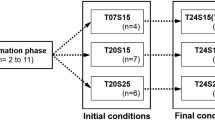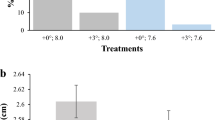Abstract
Embryos of Pseudocalanus sp. captured near Halifax, Nova Scotia, Canada, in spring take longer to develop than do those from the warmer waters of summer and autumn. This is related to the larger size of females and their eggs in the colder seasons. An experiment revealed size-assortative mating and the influence of male size as well on embryonic duration. The seasonal change is contrary to the slight reduction of embryonic duration after short-term cold acclimation of females in the laboratory. There is no evidence that embryos in the cold season develop more rapidly than expected from the overall relationship between embryonic duration and female size. However, they do, like embryos after short-term cold acclimation, develop relatively more rapidly at low temperatures; i.e., there is clockwise “rotation” of the rate-temperature response, equivalent to the temperature adaptation that has been demonstrated among species of copepods. This seasonal “rotation” may also be related to seasonal variations in size, since larger females from a given season produce embryos that show such “rotation”. Thus, there is no evidence for seasonal compensation as a consequence of temperature acclimation underlying changes that are attributable to differences in size. Evidently there is also a strong genetical component in duration of development of embryos produced by individual females.
Similar content being viewed by others
Literature Cited
Bělehrádek, J.: Temperature and living matter. Protoplasma-Monogr. 8, 1–277 (1935)
Bernard, M.: La forme elliptique de la relation temperature-durée de developpement embryonnaire chez les copépodes pelagiques et ses proprietés. In: Fourth European Marine Biology Symposium, pp 203–209. Ed. by D.J. Crisp. Cambridge: Cambridge University Press 1971
Bottrell, H.H.: The relationship between temperature and duration of egg development in some epiphytic Cladocera and Copepoda from the River Thames, Reading, with a discussion of temperature functions. Oecologia (Berl.) 18, 63–84 (1975)
Corkett, C.J.: Development rate of copepod eggs of the genus Calanus. J. exp. mar. Biol. Ecol. 10, 171–175 (1972)
— and I.A. McLaren: Relationships between development rate of copepod eggs and older stages of copepods. J. mar. biol. Ass. U.K. 50, 161–168 (1970)
Heip, C.: A comparison between models describing the influence of temperature on the development rate of copepods. Biol. Jaarb. 42, 121–125 (1974)
Landry, M.R.: Seasonal temperature effects and predicting development rates of copepods. Limnol. Oceanogr. 20, 434–440 (1975)
McLaren, I.A.: Effects of temperature on growth of zooplankton, and the adaptive value of vertical migration. J. Fish. Res. Bd Can. 20, 685–727 (1963)
—: Some relationships between temperature and egg size, body size, development rate, and fecundity, of the copepod Pseudocalanus. Limnol. Oceanogr. 10, 528–538 (1965)
—: Predicting development rate of copepod eggs. Biol. Bull. mar. biol. Lab., Woods Hole 131, 457–469 (1966)
—: Demographic strategy of vertical migration by a marine copepod. Am. Nat. 108, 91–102 (1974)
—: Ecological and genetical strategies in Pseudocalanus production. Int. Coun. Explor. Sea (Plankton Comm.) C.M. 1976/L: 5, 1–8 (1976)
—, C.J. Corkett and E.J. Zillioux: Temperature adaptations of copepod eggs from the arctic to the tropics. Biol. Bull. mar. Biol. Lab., Woods Hole 137, 486–493 (1969)
Precht, H.: Theory of temperature adaptation in cold-blooded animals. In: Physiological adaptation, pp 50–78. Ed. by C.L. Prosser. Washington, D.C.: American Physiological Society 1958
Siegel, S.: Nonparametric statistics for the behavioral sciences, 312 pp. New York: McGraw-Hill 1966
Snedecor, G.W. and W.G. Cochrane: Statistical methods, 6th ed. 593 pp. Iowa: Iowa State University Press 1967
Woods, S.M.: Polyteny and size variation in the copepod Pseudocalanus from two semi-landlocked fiords on Baffin Island. J. Fish. Res. Bd Can. 26, 543–556 (1969)
Author information
Authors and Affiliations
Additional information
Communicated by T.R. Parsons, Vancouver
Rights and permissions
About this article
Cite this article
Hart, R.C., McLaren, I.A. Temperature acclimation and other influences on embryonic duration in the copepod Pseudocalanus sp.. Mar. Biol. 45, 23–30 (1978). https://doi.org/10.1007/BF00388974
Accepted:
Issue Date:
DOI: https://doi.org/10.1007/BF00388974




